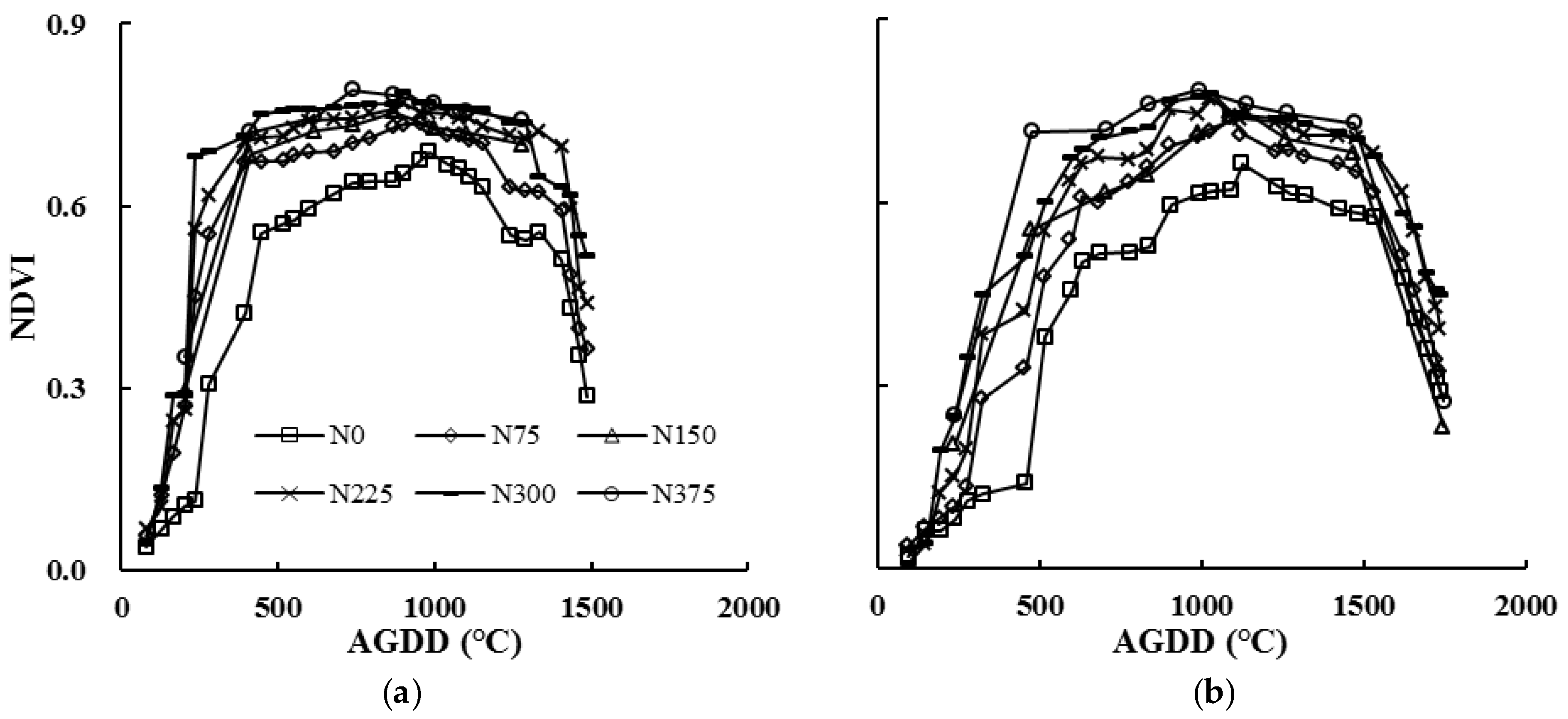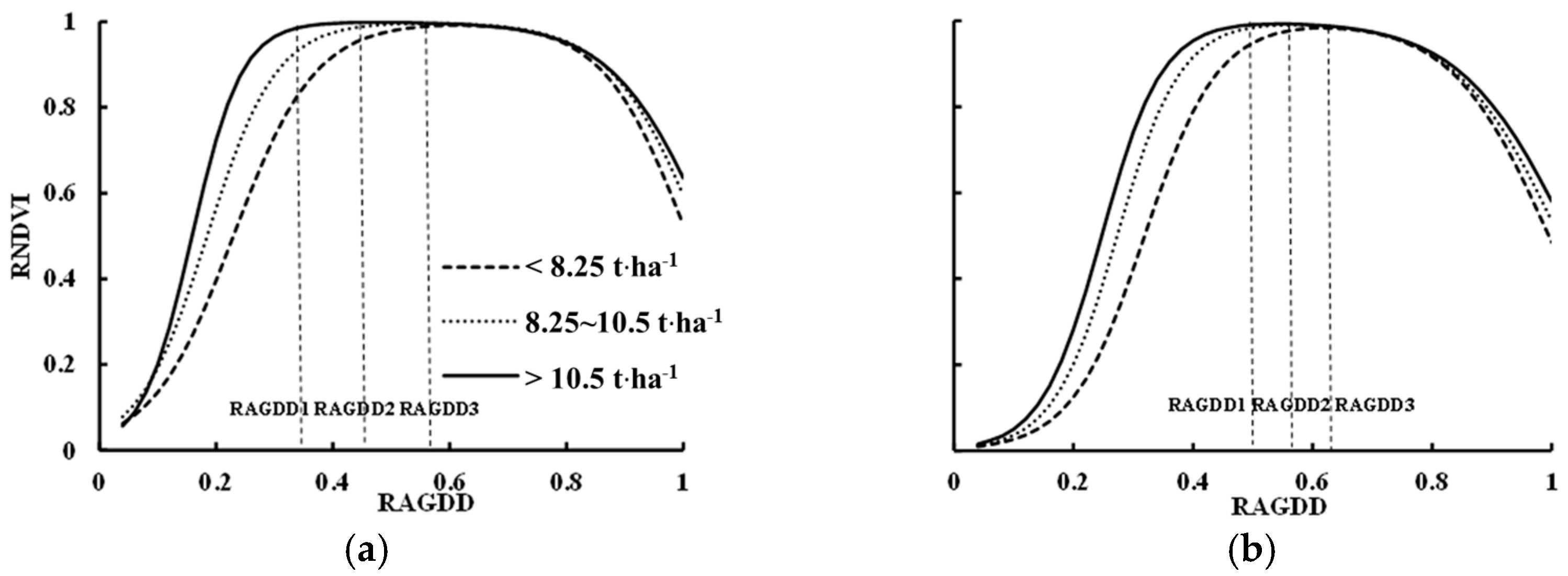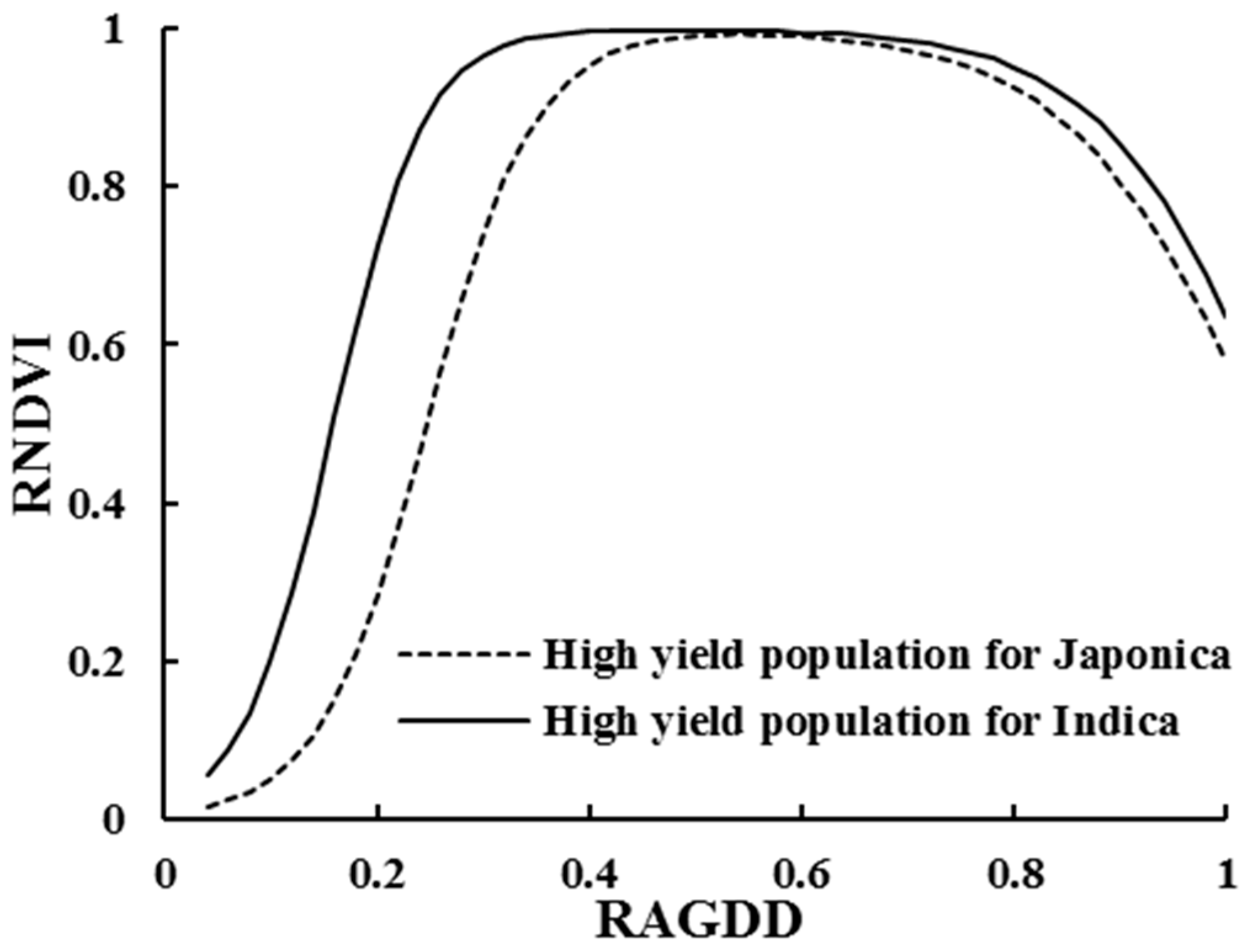Using an Active-Optical Sensor to Develop an Optimal NDVI Dynamic Model for High-Yield Rice Production (Yangtze, China)
Abstract
:1. Introduction
2. Materials and Methods
2.1. Experimental Details
2.2. Sample Collection and Measurement
2.3. Data Processing and Model Construction
2.4. Model Validation
3. Results
3.1. Dynamic Changes of the Rice Canopy NDVI
3.2. Quantitative Relationships between the Rice Canopy NDVI and Population Growth Indices
3.2.1. Quantitative Relationship between NDVI and LAI
3.2.2. Quantitative Relationship between NDVI and DM
3.2.3. Quantitative Relationship between NDVI and GY
3.3. Selection of RNDVI Dynamic Model
3.4. Establishment of the RNDVI Dynamic Models
3.5. Model Validation
4. Discussion
5. Conclusions
Acknowledgments
Author Contributions
Conflicts of Interest
References
- Ata-Ul-Karim, S.T.; Yao, X.; Liu, X.J.; Cao, W.X.; Zhu, Y. Development of critical nitrogen dilution curve of Japonica rice in Yangtze River Reaches. Field Crops Res. 2013, 149, 149–158. [Google Scholar] [CrossRef]
- Ling, Q.H. Crop Population Quality; Shanghai Scientific & Technical Publisher: Shanghai, China, 2000; pp. 40–45. [Google Scholar]
- Ling, Q.H. Rice Precise Quantitative Cultivation Theory and Technology; China Agriculture Press: Beijing, China, 2007; pp. 123–128. [Google Scholar]
- Yu, Q.; Fu, B.P.; Yao, K.M. A universal growth model on rice LAI. Agric. Meteorol. 1995, 16, 6–8. [Google Scholar]
- Cao, H.X.; Dong, Y.H.; Wang, X.Q.; Xu, J.F.; Gao, L.Z. Studies of dynamic simulation models of optimum leaf area index of wheat under different yielding levels. J. Triticeae Crops. 2006, 26, 128–131. [Google Scholar]
- Liu, Z.D.; Duan, A.W.; Gao, Y.; Liu, H. Study on dynamic model of leaf area index (LAI) for winter wheat in Xinxiang area. J. Triticeae Crops. 2008, 4, 680–685. [Google Scholar]
- Wang, N.Z.; Li, Z.; Huang, B.; Ma, S.J.; Chen, Y.H. The impact of precipitation to leaf area and dry matter accumulate and yield of maize on Loess Plateau. J. Maize Sci. 2007, 1, 100–102. [Google Scholar]
- Lin, Z.H.; Xiang, Y.Q.; Mo, X.G.; Li, J.; Wang, L. Normalized leaf area index model for summer maize. Chin. J. Eco-Agric. 2003, 11, 69–72. [Google Scholar]
- Zhang, X.D.; Cai, H.J.; Fu, Y.J.; Wang, J. Study on leaf area index of summer maize in loess areas. Agric. Res. Arid Areas. 2006, 24, 25–29. [Google Scholar]
- Wang, X.L. Logistic simulating model on crop dry matter accumulating dynamics. Agric. Meteorol. 1986, 7, 14–19. [Google Scholar]
- Zhang, B.; Zhao, M.; Dong, Z.Q.; Li, J.G.; Chen, C.Y.; Sun, R. Establishment and test of LAI dynamic simulation model for high yield population. Acta Agron. Sin. 2007, 33, 612–619. [Google Scholar]
- Hou, Y.H.; Chen, C.Y.; Guo, Z.Q.; Hou, L.B.; Dong, Z.Q.; Zhao, M. Establishment of dry matter accumulation dymamic simulation model and analysis of growth charateristc for high-yielding population of spring maize. J. Maize Sci. 2008, 16, 90–95. [Google Scholar]
- Chen, J.F.; Chen, K.M.; Xu, J.B. Research on the remote sensing monitoring of grassland productivity based on TM-NDVI. Agric. Sci. Technol. 2011, 12, 119–122. [Google Scholar]
- Sharma, L.K.; Bu, H.G.; Denton, A.; Franzen, D.W. Active-Optical Sensors Using Red NDVI Compared to Red Edge NDVI for Prediction of Corn Grain Yield in North Dakota, U.S.A. Sensors 2015, 15, 27832–27853. [Google Scholar] [CrossRef] [PubMed]
- Liu, N.S.; Cao, W.X.; Zhu, Y.; Zhang, J.C.; Pang, F.R.; Ni, J. The Node Deployment of Intelligent Sensor Networks Based on the Spatial Difference of Farmland Soil. Sensors 2015, 15, 28314–28339. [Google Scholar] [CrossRef] [PubMed]
- Lukina, E.V.; Freeman, K.W.; Wynn, K.J.; Thomason, W.E.; Mullen, R.W.; Stone, M.L.; Solie, J.B.; Klatt, A.R.; Johnson, G.V.; Elliott, R.L.; et al. Nitrogen fertilization optimization algorithm based on in-season estimates of yield and plant nitrogen uptake. J. Plant Nutr. 2007, 24, 885–898. [Google Scholar] [CrossRef]
- Franzen, D.W.; Sharma, L.K.; Bu, H. Active Optical Sensor Algorithms for Corn Yield Prediction and a Corn Side-Dress Nitrogen Rate Aid; North Dakota State University Extension Service: Fargo, ND, USA, 2014. [Google Scholar]
- Raun, W.R.; Solie, J.B.; Johnson, G.V.; Stone, M.L.; Mullen, R.W.; Freeman, K.W.; Thomason, W.E.; Lukina, E.V. Improving nitrogen use efficiency in cereal grain production with optical sensing and variable rate application. Agron J. 2002, 94, 815–820. [Google Scholar] [CrossRef]
- Raun, W.R.; Solie, J.B.; Stone, M.L.; Martin, K.L.; Freeman, K.W.; Mullen, R.W.; Zhang, H.N.; Schepers, J.S.; Johnson, G.V. Optical sensor-based algorithm for crop nitrogen fertilization. Soil Sci. Plant Anal. 2005, 36, 2759–2781. [Google Scholar] [CrossRef]
- Nguyen, H.T.; Lee, K.; Lee, B.W. Recommendation of nitrogen topdressing rates at panicle initiation stage of rice using canopy reflectance. J. Crop Sci. Biotechnol. 2008, 11, 141–150. [Google Scholar]
- Tubana, B.S.; Harrell, D.; Walker, T.; Phillips, S. Midseason nitrogen fertilization rate decision tool for rice using remote sensing technology. Better Crops. 2011, 95, 22–24. [Google Scholar]
- Raun, W.R.; Solie, J.B.; Johnson, G.V.; Stone, M.L.; Lukina, E.V.; Thomason, W.E.; Chepers, J.S. In-season prediction of potential grain yield in winter wheat using canopy reflectance. Agron. J. 2001, 93, 131–138. [Google Scholar] [CrossRef]
- Franzen, D.W.; Kitchen, N.; Holland, K.; Schepers, J.; Raun, W. Algorithms for in-season nutrient management in cereals. Agron J. 2016, 108, 1775–1781. [Google Scholar] [CrossRef]
- Sharma, L.K.; Bu, H.; Franzen, D.W.; Denton, A. Use of corn height measured with an acoustic sensor improves yield estimation with ground based active optical sensors. Comput. Electron. Agric. 2016, 124, 254–262. [Google Scholar] [CrossRef]
- Xue, L.H.; Li, G.H.; Qin, X.; Yang, L.Z.; Zhang, H.N. Topdressing nitrogen recommendation for early rice with an active sensor in south China. Precis. Agric. 2014, 15, 95–110. [Google Scholar] [CrossRef]
- Xue, L.H.; Yang, L.Z. Recommendations for nitrogen fertilizer topdressing rates in rice using canopy reflectance spectra. Biosyst. Eng. 2008, 100, 524–534. [Google Scholar] [CrossRef]
- Yao, X.F. Non-Destructive Monitoring and Precise Regulation of Plant Nitrogen Nutrition in Wheat; Nanjing Agricultural University: Nanjing, China, 2012. [Google Scholar]
- Zheng, H.B.; Cheng, T.; Yao, X.; Deng, X.Q.; Tian, Y.C.; Cao, W.X.; Zhu, Y. Detection of rice phenology through time series analysis of ground-based spectral index data. Field Crops Res. 2016, 198, 131–139. [Google Scholar] [CrossRef]
- Osborne, S.L. Utilization of Existing Technology to Evaluate Spring Wheat Growth and Nitrogen Nutrition in South Dakota. Commun. Soil Sci. Plant Anal. 2007, 38, 949–958. [Google Scholar] [CrossRef]
- Du, Y.L.; Wang, Q.S.; Wang, C.L.; Ding, Y.F. Yield potential of rice and technical approaches to high yield in Jiangsu province. Jiangsu J. Agric. Sci. 2011, 27, 926–932. [Google Scholar]
- Ata-Ul-Karim, S.T.; Zhu, Y.; Yao, X.; Cao, W.X. Determination of critical nitrogen dilution curve based on leaf area index in rice. Field Crops Res. 2014, 167, 76–85. [Google Scholar] [CrossRef]
- Yao, X.; Ata-Ul-Karim, S.T.; Zhu, Y.; Tian, Y.C.; Liu, X.J.; Cao, W.X. Development of critical nitrogen dilution curve in rice based on leaf dry matter. Eur. J. Agron. 2014, 55, 20–28. [Google Scholar] [CrossRef]
- Clevers, J.G.P.W.; Büker, C.; Leeuwen, H.J.C.V.; Bouman, B.A.M. A framework for monitoring crop growth by combining directional and spectral remote sensing information. Remote Sens. 1994, 50, 161–170. [Google Scholar] [CrossRef]
- Wang, R.C.; Wang, K.; Shen, Z.Q.; Jiang, H.X.; Zhu, D.F.; Cai, T.C. A study on modeling of rice yield estimation by remote sensing. J. Remote Sens. 1998, 2, 19–124. [Google Scholar]
- Lu, Y.L.; Bai, Y.L.; Yang, L.P.; Wang, L. Diagnosis on nitrogen status using GreenSeeker in spring maize. J. Maize Sci. 2008, 16, 111–114. [Google Scholar]
- Wang, L.; Bai, Y.L.; Lu, Y.L.; Wang, H.; Yang, L.P. NDVI analysis and yield estimation in winter wheat based on GreenSeeker. Acta Agron. Sin. 2012, 38, 747–753. [Google Scholar] [CrossRef]
- Ali, A.M.; Thind, H.S.; Singh, V.; Singh, B. A framework for refining nitrogen management in dry direct-seeded rice using GreenSeeker™ optical sensor. Comput. Electron. Agric. 2015, 110, 114–120. [Google Scholar] [CrossRef]
- Shaver, T.; Khosla, R.; Westfall, D. Evaluation of two crop canopy sensors for nitrogen recommendations in irrigated maize. J. Plant Nutr. 2014, 37, 406–419. [Google Scholar] [CrossRef]
- Zhang, H.C.; Gong, J.L. Research status and development discussion on high-yielding agronomy of mechanized planting rice in China. Acta Agron. Sin. 2014, 47, 1273–1289. [Google Scholar]
- Chen, Q.C.; Tian, Y.C.; Yao, X.; Zhu, Y.; Cao, W.X. Effects of nitrogen fertilizer top-dressing based on canopy reflectance spectra in rice. Sci. Agric. Sin. 2010, 43, 4149–4157. [Google Scholar]
- Calvo, R.N.I.; Rozas, H.S.; Echeverría, H.; Diovisalvi, N. Using canopy indices to quantify the economic optimum nitrogen rate in spring wheat. Agron. J. 2015, 107, 459–465. [Google Scholar] [CrossRef]
- Singh, B.; Singh, V.; Purba, J.; Sharma, R.K.; Jat, M.L.; Singh, Y.; Thind, H.S.; Gupta, R.K.; Chaudhary, O.P.; Chandna, P.; et al. Site-specific fertilizer nitrogen management in irrigated transplanted rice (Oryza sativa) using an optical sensor. Precis. Agric. 2015, 16, 1–21. [Google Scholar]
- Schmidt, J.; Beegle, D.; Zhu, Q.; Sripada, R. Improving in-season nitrogen recommendations for maize using an active sensor. Field Crops Res. 2011, 120, 94–101. [Google Scholar] [CrossRef]
- Yao, Y.X.; Miao, Y.X.; Huang, S.Y.; Gao, L.; Ma, X.B.; Zhao, G.M.; Jiang, R.F.; Chen, X.P.; Zhang, F.S.; Yu, K. Active canopy sensor-based precision N management strategy for rice. Agron. Sustain. Dev. 2012, 32, 925–933. [Google Scholar] [CrossRef]
- Goswami, S.; Gamon, J.; Vargas, S.; Tweedie, C. Relationships of NDVI, Biomass, and Leaf Area Index (LAI) for six key plant species in Barrow, Alaska. PeerJ PrePrints 2015, 3, e913v1. [Google Scholar]






| Experiment NO. | Location | Cultivar | N Rate (kg·ha–1) | Plot Size (m2) | Transplanting Date (Month/Day) | Sampling Date (Month/Day) |
|---|---|---|---|---|---|---|
| EXP. 1 in 2008 | Nanjing | LYP9 (Indica) | 0, 110, 220, 330 | 4.5 × 6.5 = 29.25 | 6/23 | 07/16, 07/20, 07/26, 07/30, 08/03, 08/08, 08/13, 08/18, 08/23, 08/28, 08/31, 09/05 |
| EXP. 2 in 2009 | Nanjing | LYP9 (Indica) | 0, 180, 360 | 5.0 × 6.0 = 30.0 | 6/17 | 07/15, 07/19, 07/25, 07/30, 08/04, 08/07, 08/13, 08/17, 08/22, 08/27, 09/02, 09/06 |
| EXP. 3 in 2013 | Rugao | WXJ14 (Japonica) | 0, 75, 150, 225, 300, 375 | 5.0 × 6.0 = 30.0 | 6/22 | 06/28, 07/03, 07/08, 07/11, 07/19, 08/08, 08/12, 08/15, 08/19, 08/25, 09/17, 09/21, 09/25, 10/02, 10/10, 10/11 |
| SY63 (Indica) | ||||||
| EXP. 4 in 2014 | Rugao | WXJ24 (Japonica) | 0, 75, 150, 225, 300, 375 | 6.0 × 7.0 = 42.0 | 6/17 | 06/23, 06/27, 06/30, 07/03, 07/06, 07/09, 07/17, 07/20, 07/24, 07/26, 07/29, 08/03, 08/06, 08/10, 08/16, 08/19, 08/23, 08/25, 08/30, 09/02, 09/05, 09/08, 09/16, 09/21, 09/25, 10/02, 10/06, 10/10, 10/14 |
| YLY1 (Indica) | ||||||
| EXP. 5 in 2014 | Rugao | WYJ24 LJ7 ZD11 | 0, 110, 220, 330 | 5.0 × 6.0 = 30.0 | 6/17 | 7/18, 7/30, 08/06, 08/16, 08/26, 09/04 |
| NJ4 (Japonica) |
| Items | NDVImax | DAT(d)/AGDD (°C) When Obtaining the NDVImax Value | |||||||
|---|---|---|---|---|---|---|---|---|---|
| Year | 2013 | 2014 | 2013 | 2014 | |||||
| Cultivar | WXJ14 (Japonica) | SY63 (Indica) | WYJ24 (Japonica) | YLY1 (Indica) | WXJ14 (Japonica) | SY63 (Indica) | WYJ24 (Japonica) | YLY1 (Indica) | |
| N Treatment | 0 | 0.489d | 0.689c | 0.663c | 0.688c | 65a/1285.5a | 65a/1155.5a | 70a/1123.5b | 69a/983.5a |
| 75 | 0.632c | 0.759b | 0.737b | 0.736b | 65a/1285.5a | 59ab/1052b | 68b/1092.5c | 67b/956.5b | |
| 150 | 0.645bc | 0.870a | 0.746b | 0.754ab | 59b/1170b | 59ab/1052b | 70a/1139a | 60d/869.5d | |
| 225 | 0.659b | 0.880a | 0.769a | 0.769ab | 59b/1170b | 59ab/1052b | 64c/1030.5d | 63c/902.5c | |
| 300 | 0.660b | 0.886a | 0.777a | 0.787a | 55c/1089.5c | 55b/979.5c | 64c/1030.5d | 63c/902.5c | |
| 375 | 0.691a | 0.888a | 0.784a | 0.790a | 55c/1089.5c | 55b/979.5c | 60d/991.5e | 50e/736.5e | |
| Simulated Models | Parameters | R2 | RMSE | |||
|---|---|---|---|---|---|---|
| a | b | c | d | |||
| 15.2829 | 0.1944 | 11.6517 | 1.0267 | 0.8577 | 0.1161 | |
| –0.3796 | 5.7851 | –7.4437 | 2.7004 | 0.8357 | 0.1357 | |
| –0.4319 | 5.3826 | –0.3948 | 6.1176 | 0.8319 | 0.1373 | |
| –0.1741 | 0.0010 | 0.8720 | 3.5469 | 0.7671 | 0.1616 | |
| 0.8635 | 97.9447 | 27.3641 | – | 0.7549 | 0.1674 | |
| Cultivar Type | Yield Level | N Rate | Cultivar | Yield | NDVImax Value | Entire Growing Period | Parameter | R2 | RMSE |
|---|---|---|---|---|---|---|---|---|---|
| (t·ha–1) | (kg·ha–1) | (t·ha–1) | (days) | ||||||
| Japonica | Low (yield ≤ 8.25 t·ha–1) | 0 | WXJ14 | 6.08 | 0.489 | 150 | a: 16.4599 | 0.8834 | 0.1370 |
| WYJ24 | 6.70 | 0.663 | 156 | b: 0.3090 | |||||
| 75 | WXJ14 | 7.75 | 0.632 | 150 | c: 12.3144 | ||||
| WYJ24 | 7.87 | 0.737 | 156 | d: 0.9851 | |||||
| Middle (8.25 t·ha–1 < yield < 10.5 t·ha–1) | 150 | WXJ14 | 8.78 | 0.645 | 150 | a: 19.0544 | 0.9024 | 0.1224 | |
| WYJ24 | 8.98 | 0.746 | 156 | b: 0.2629 | |||||
| 225 | WXJ14 | 9.08 | 0.659 | 150 | c: 11.4756 | ||||
| WYJ24 | 9.62 | 0.769 | 156 | d: 1.0022 | |||||
| High (yield ≥ 10.5 t·ha–1) | 300 | WXJ14 | 10.53 | 0.660 | 150 | a: 20.0313 | 0.8764 | 0.1367 | |
| WYJ24 | 10.54 | 0.777 | 156 | b: 0.2370 | |||||
| 375 | WXJ14 | 10.61 | 0.691 | 150 | c: 10.9741 | ||||
| WYJ24 | 10.63 | 0.784 | 156 | d: 1.0195 | |||||
| Indica | Low (yield ≤ 8.25 t·ha–1) | 0 | SY63 | 6.16 | 0.689 | 153 | a: 14.3656 | 0.8713 | 0.1175 |
| YLY1 | 7.01 | 0.688 | 133 | b: 0.2196 | |||||
| 75 | SY63 | 8.17 | 0.759 | 153 | c: 14.0343 | ||||
| YLY1 | 8.20 | 0.736 | 133 | d: 0.9972 | |||||
| Middle (8.25 t·ha–1 < yield < 10.5 t·ha–1) | 150 | SY63 | 9.04 | 0.870 | 153 | a: 17.1028 | 0.8610 | 0.1128 | |
| YLY1 | 9.25 | 0.754 | 133 | b: 0.1749 | |||||
| 225 | SY63 | 9.86 | 0.880 | 153 | c: 13.2413 | ||||
| YLY1 | 10.13 | 0.769 | 133 | d: 1.0192 | |||||
| High (yield ≥10.5 t·kg·ha–1) | 300 | SY63 | 10.61 | 0.886 | 153 | a: 23.8261 | 0.8874 | 0.0981 | |
| YLY1 | 10.83 | 0.787 | 133 | b: 0.1489 | |||||
| 375 | SY63 | 11.02 | 0.888 | 153 | c: 12.0923 | ||||
| YLY1 | 11.26 | 0.790 | 133 | d: 1.0361 |
| Growth Stage | k | R2 | RMSE | |||
|---|---|---|---|---|---|---|
| Japonica | Indica | Japonica | Indica | Japonica | Indica | |
| Active tillering | 0.9749 | 1.0158 | 0.7044 ** | 0.6102 ** | 0.0305 | 0.0128 |
| Middle tillering | 1.0187 | 1.0318 | 0.7689 ** | 0.7990 ** | 0.0164 | 0.0075 |
| Jointing | 1.0045 | 1.0330 | 0.9331 ** | 0.6656 ** | 0.0079 | 0.0105 |
| Booting | 1.0160 | 1.0098 | 0.6565 ** | 0.7367 ** | 0.0191 | 0.0113 |
| Heading | 1.0086 | 0.9859 | 0.9167 ** | 0.8211 ** | 0.0174 | 0.0064 |
| Flowering | 0.9692 | 1.0333 | 0.8762 ** | 0.6357 ** | 0.0119 | 0.0128 |
| Active tillering to flowering | 0.9991 | 1.0170 | 0.9084 ** | 0.8030 ** | 0.0232 | 0.0170 |
© 2017 by the authors. Licensee MDPI, Basel, Switzerland. This article is an open access article distributed under the terms and conditions of the Creative Commons Attribution (CC BY) license (http://creativecommons.org/licenses/by/4.0/).
Share and Cite
Liu, X.; Ferguson, R.B.; Zheng, H.; Cao, Q.; Tian, Y.; Cao, W.; Zhu, Y. Using an Active-Optical Sensor to Develop an Optimal NDVI Dynamic Model for High-Yield Rice Production (Yangtze, China). Sensors 2017, 17, 672. https://doi.org/10.3390/s17040672
Liu X, Ferguson RB, Zheng H, Cao Q, Tian Y, Cao W, Zhu Y. Using an Active-Optical Sensor to Develop an Optimal NDVI Dynamic Model for High-Yield Rice Production (Yangtze, China). Sensors. 2017; 17(4):672. https://doi.org/10.3390/s17040672
Chicago/Turabian StyleLiu, Xiaojun, Richard B. Ferguson, Hengbiao Zheng, Qiang Cao, Yongchao Tian, Weixing Cao, and Yan Zhu. 2017. "Using an Active-Optical Sensor to Develop an Optimal NDVI Dynamic Model for High-Yield Rice Production (Yangtze, China)" Sensors 17, no. 4: 672. https://doi.org/10.3390/s17040672
APA StyleLiu, X., Ferguson, R. B., Zheng, H., Cao, Q., Tian, Y., Cao, W., & Zhu, Y. (2017). Using an Active-Optical Sensor to Develop an Optimal NDVI Dynamic Model for High-Yield Rice Production (Yangtze, China). Sensors, 17(4), 672. https://doi.org/10.3390/s17040672









